신생아의 대변, Stool of newborn infants
- 출생하기 전 태아가 자궁 속에서 태변을 누기도 하고 질 산도 속에서도 누기도 하고 태어나자마자 뱃속에 있던 대변(배안 똥)을 누기도 한다. 이런 대변을 태변(Meconium)이라고 한다.
- 다시 설명하면, 분만이 시작되기 전 자궁 속에서 태아가 태변을 쌀 수 있고 그 싼 태변이 양수와 섞일 수 있다.
- 분만 중 태아가 태변을 양수 속이나 산도 속에 쌀 수 있다. 또는 출생 후 태변을 곧 바로 쌀 수 있다.
- 대부분의 신생들은 출생 후 1∼3일까지 태변을 거의 다 보는 것이 보통이다.
- 출생 후 맨 처음 본 태변이나 그 다음 몇 번 본 태변은 고약같이 끈적끈적하고 흑갈색이거나 암녹색이다.
- 생후 1∼3일까지 거의 대부분의 신생아들은 태변을 적어도 하루 동안 한 번 본다.
- 그 후 신생아들이 먹는 젖이나 인공영양의 종류에 따라 대변의 색깔과 형태가 조금 다르다.
- 생후 3∼5일 이후부터 태변을 더 이상 누지 않는 것이 정상이다.
- 엄마의 젖만 먹는 신생아들의 대부분은 노란 고추씨 덩어리같이 몽글몽글한 대변 덩어리가 섞인 묽은 노란 설사 변을 정상으로 본다.
- 인공영양을 먹는 대부분의 신생아들의 대변은 모유를 먹는 아기의 대변과 거의 비슷하게 생겼지만 덜 노랗다.
- 뉴트라미젠 저 알레르기 특수 인공영양을 먹는 신생아들이나 영유아들의 대변은 푸르스름하고 설사 변과 비슷하게 누는 것이 보통이고 정상적이다.
- 분만이 시작하기 바로 전 자궁 속에서, 또는 분만 중 자궁 속에서 태아가 태변을 양수에 쌀 수 있다.
- 태변이 섞인 양수가 기도 속으로 흡인되어 태변 흡인성 폐렴이 태아에게 생길 수 있다(부모도 반의사가 되어야 한다- 소아가정간호 백과-제9권 소아청소년 소화기 질환-태변 흡인성 폐렴 참조).
- 갓 태어난 건강한 신생아들의 대부분이 생후 12시간 이내 적어도 한번 정도 태변을 보는 것이 정상이다.
- 드물게 생후 3∼4일경 태변을 처음 누는 신생아들도 있다.
- 생후 2∼3일까지 태변을 누지 않더라도 신생아가 모유나 인공영양을 잘 먹고 잠을 잘 자고 토하지 않고 배가 비정상 적으로 부르지 않고 아픈 것 같지 않으면 대변을 정상적으로 본다고 간주 할 수수 있다.
- 갓 태어난 신생아들이 생후 2∼3일까지 태변을 누지도 않고, 배가 부르고 구토하고 아픈 것같이 보이면 의사에게 곧 문의한다.
- 태변을 더 이상 보지 않은 때부터 건강한 대부분의 신생아들은 하루에 2∼3회 대변을 본다.
- 모유나 인공영양을 충분히 먹는 신생아들의 일부는 모유나 인공영양을 먹은 후 바로 대변을 보고 노란 물똥 대변을 정상적으로 하루 3∼7번 정도 볼 수 있다.
- 모유나 인공영양을 충분히 먹고 체중이 정상적으로 계속 늘면서 정상적으로 잘 자라고 아무 병이 없으면 설사 같은 묽은 대변을 하루 일곱 번 정도 보아도 걱정할 필요가 없다.
- 그와 반대로 하루 종일 대변을 한 번도 보지 않는 신생아들도 있다.
- 대변을 2∼3일마다 한번 정도 정상적으로 보는 신생아들도 많다(부모도 반의사가 되어야 한다- 소아가정간호 백과-제 9권 소아청소년 소화기 질환-정상 대변 참조).
- 학령기 전 유아들이나 학령기 아이들이 대변을 볼 때와 같이 신생아들이 대변을 볼 때 얼굴을 붉히면서 배에 힘을 정상적으로 많이 주기도 한다.
- 그렇지만 대변이 굳지 않고 물기가 적절히 있고 굵지 않고 정상 대변과 같이 누면 변비가 아니므로 걱정할 필요가 없다.
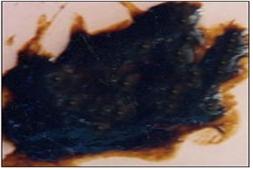
사진 2-120. 갓 태어난 신생아가 본 첫 태변
Copyright ⓒ 2012 John Sangwon Lee, MD., FAAP
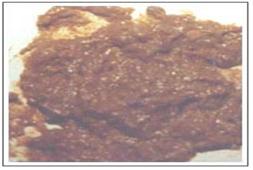
사진 2-121. 모유를 먹기 시작한 이후 신생아가 본 태변과 모유를 먹을 때 본 모유변이 섞인 대변
Copyright ⓒ 2012 John Sangwon Lee, MD., FAAP

사진 2-122. 태변과 모유를 먹기 시작한 신생아들이 본 모유변이 섞인 대변
Copyright ⓒ 2012 John Sangwon Lee, MD., FAAP
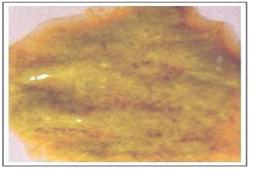
사진 2-123. 모유를 먹는 신생아가 본 정상 모유변. 어떤 병으로 인해 눈 설사변이 아니다.
Copyright ⓒ 2012 John Sangwon Lee, MD., FAAP
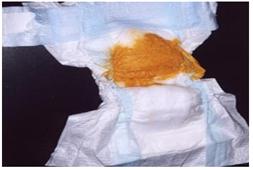
사진 2-124. 모유를 먹는 신생아가 본 정상 모유변. 어떤 병으로 본 설사변이 아니다.
Copyright ⓒ 2012 John Sangwon Lee, MD., FAAP

사진 2-125 모유를 먹는 신생아가 본 정상 모유변. 어떤 병으로 본 설사변이 아니다.
Copyright ⓒ 2012 John Sangwon Lee, MD., FAAP
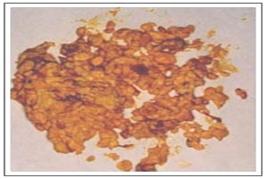
사진2-126. 엄마의 젖만 먹는 신생아들의 대부분은 노란 고추씨 덩어리와 비슷한 몽글몽글한 대변 덩어리가 섞인 묽은 물똥을 정상적으로 본다.
Copyright ⓒ 2012 John Sangwon Lee, MD., FAAP

사진 2-127. 인공영양을 먹는 신생아의 정상변
Copyright ⓒ 2012 John Sangwon Lee, MD., FAAP

사진 2-128. 신생아의 설사 변 대변의 형태가 없다
Copyright ⓒ 2012 John Sangwon Lee, MD., FAAP
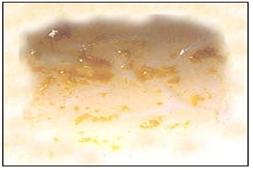
사진 2-129. 신생아의 설사 변 소화되지 않은 음 식물이 대변으로 나올 수 있다.
Copyright ⓒ 2012 John Sangwon Lee, MD., FAAP
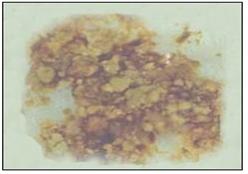
사진 2-130. 뉴트라미젠은 단백질을 가수분해해서 조제한 저 알레르기 인공영양의 일종이다. 뉴트라미젠을 먹는 신생아들이나 영아들의 대변의 색깔은 푸를 수 있다. 그리고 대변이 설사 변과 같이 묽은 것이 보통이다.
Copyright ⓒ 2012 John Sangwon Lee, MD., FAAP
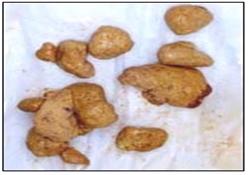
사진 2-131. 신생아의 변비 변. 변의 수분기가 정상보다 적고 굳은 변을 변비 변이라 한다.
Copyright ⓒ 2012 John Sangwon Lee, MD., FAAP
Stool of newborn infants
• Before birth, the fetus has meconium in the womb, sometimes in the vaginal birth canal, and sometimes the feces in the womb immediately after birth. This stool is called meconium.
• To reiterate, the fetus can have meconium in the womb before labor begins, and the fetus meconium can be mixed with amniotic fluid.
• During labor, the fetus may pass meconium into the amniotic fluid or the birth canal. Alternatively, newborns can have meconium right after birth.
• It is normal for most newborns to see almost all of the meconium by the first to third days after birth.
• The first meconium after birth or the next few times is sticky and dark brown or green.
• By day 1-3, most newborns have meconium at least once a day.
• After that, the color and shape of the feces are slightly different depending on the type of breast milk or artificial nutrition that newborns eat.
• It is normal not to have meconium anymore from 3 to 5 days after birth.
• Most newborns who are fed only mother’s milk see it as normal to have watery yellow diarrhea mixed with lumpy stools like yellow pepper seeds.
• The stools of most infants fed artificial nutrition look almost identical to the stools of breastfed babies, but less yellow.
• It is normal for newborns or infants to take Nutramigen hypoallergenic special artificial nutrition and have bluish stools, similar to diarrhea.
• In the womb just before labor begins, or in the uterus during labor, the fetus may pass meconium into the amniotic fluid.
• Amniotic fluid mixed with meconium can be aspirated into the airways, causing fetuses to develop meconium aspiration pneumonia www.drleepediatrics.com – Volume 9 Pediatric Gastrointestinal Diseases – Meconium Aspiration Pneumonia).
• It is normal for most healthy newborns to have at least one meconium within the first 12 hours of life.
• Rarely, some newborns have meconium for the first time around 3-4 days after birth.
• Even if you do not have meconium by the 2nd or 3rd day after birth, your newborn can be considered to pass stool normally if he/she eats breast milk or artificial nutrition well, sleeps well, does not vomit, does not feel abnormally full and does not feel sick.
• If newborns do not have meconium by the 2nd or 3rd day of life and appear full, vomit and sick, see a doctor right away.
• Most healthy newborns from the time they no longer have meconium have two or three bowel movements per day.
• Some newborns who are fed enough breast milk or artificial nutrition may pass stool immediately after breastfeeding or artificial nutrition, and normally have yellow watery stool 3 to 7 times a day.
• If you eat enough breast milk or artificial nutrition, gain weight normally, grow normally, and have no disease, there is no need to worry if you have loose stools such as diarrhea 7 times a day.
• Conversely, some newborns do not have a bowel movement all day.
• Many newborns have a bowel movement normally once every two to three days-www.drleepediatrics.com – Vol. 9 Gastrointestinal diseases in children and adolescents – Normal stool).
• Newborns may blush when they have a bowel movement, such as preschool children and school-age children, which normally gives a lot of pressure on the stomach.
• However, if the stool is not hardened, has adequate moisture, is not thick, and is laid like normal stool, there is no need to worry as it is not constipated.

Picture 2-120. First meconium is seen by a newborn baby. Copyright ⓒ 2012 John Sangwon Lee, MD., FAAP

Picture 2-121. Meconium stool is seen by newborns after starting to breastfeed and stool mixed with breast milk seen when breastfeeding. Copyright ⓒ 2012 John Sangwon Lee, MD., FAAP

Picture 2-122. Meconium and feces mixed with breast milk seen by newborns who started breastfeeding. Copyright ⓒ 2012 John Sangwon Lee, MD., FAAP

Picture 2-123. Normal breastfeeding is seen in breastfed newborns. Eye diarrhea is not due to some disease. Copyright ⓒ 2012 John Sangwon Lee, MD., FAAP

Picture 2-124. Normal breastfeeding is seen in breastfed newborns. It is not diarrhea seen as a disease of any kind. Copyright ⓒ 2012 John Sangwon Lee, MD., FAAP

Picture 2-125 Normal breastfeeding seen by a breastfed newborn. It is not diarrhea seen as a disease of any kind. Copyright ⓒ 2012 John Sangwon Lee, MD., FAAP

Picture 2-126. Most newborns fed only on mother’s milk normally see watery feces mixed with lumps of feces similar to lumps of yellow pepper seeds. Copyright ⓒ 2012 John Sangwon Lee, MD., FAAP

Picture 2-127. Normal stools in newborns fed artificial nutrition. Copyright ⓒ 2012 John Sangwon Lee, MD., FAAP

Picture 2-128. Absence of form of diarrhea stool in newborns. Copyright ⓒ 2012 John Sangwon Lee, MD., FAAP

Picture 2-129. Diarrhea in newborns. Undigested food may be excreted in the feces. Copyright ⓒ 2012 John Sangwon Lee, MD., FAAP

Picture 2-130. Neutramigen is a kind of hypoallergenic artificial nutrition prepared by hydrolyzing protein. Newborns and infants taking Neutramigen may have blue stools. And it is common for the stool to be watery like diarrhea stool. Copyright ⓒ 2012 John Sangwon Lee, MD., FAAP

Picture 2-131. Constipation in newborns. Constipation is when the water content of the stool is less than normal and the stool is hard. Copyright ⓒ 2012 John Sangwon Lee, MD., FAAP
출처 및 참조문헌
- www.drleepediatrics.com 제1권 소아청소년 응급 의료
- www.drleepediatrics.com 제2권 소아청소년 예방
- www.drleepediatrics.com 제3권 소아청소년 성장 발육 육아
- www.drleepediatrics.com 제4권 모유,모유수유, 이유
- www.drleepediatrics.com 제5권 인공영양, 우유, 이유식, 비타민, 미네랄, 단백질, 탄수화물, 지방
- www.drleepediatrics.com 제6권 신생아 성장 발육 육아 질병
- www.drleepediatrics.com제7권 소아청소년 감염병
- www.drleepediatrics.com제8권 소아청소년 호흡기 질환
- www.drleepediatrics.com제9권 소아청소년 소화기 질환
- www.drleepediatrics.com제10권. 소아청소년 신장 비뇨 생식기 질환
- www.drleepediatrics.com제11권. 소아청소년 심장 혈관계 질환
- www.drleepediatrics.com제12권. 소아청소년 신경 정신 질환, 행동 수면 문제
- www.drleepediatrics.com제13권. 소아청소년 혈액, 림프, 종양 질환
- www.drleepediatrics.com제14권. 소아청소년 내분비, 유전, 염색체, 대사, 희귀병
- www.drleepediatrics.com제15권. 소아청소년 알레르기, 자가 면역질환
- www.drleepediatrics.com제16권. 소아청소년 정형외과 질환
- www.drleepediatrics.com제17권. 소아청소년 피부 질환
- www.drleepediatrics.com제18권. 소아청소년 이비인후(귀 코 인두 후두) 질환
- www.drleepediatrics.com제19권. 소아청소년 안과 (눈)질환
- www.drleepediatrics.com 제20권 소아청소년 이 (치아)질환
- www.drleepediatrics.com 제21권 소아청소년 가정 학교 간호
- www.drleepediatrics.com 제22권 아들 딸 이렇게 사랑해 키우세요
- www.drleepediatrics.com 제23권 사춘기 아이들의 성장 발육 질병
- www.drleepediatrics.com 제24권 소아청소년 성교육
- www.drleepediatrics.com 제25권 임신, 분만, 출산, 신생아 돌보기
- Red book 29th-31st edition 2021
- Nelson Text Book of Pediatrics 19th- 21st Edition
- The Johns Hopkins Hospital, The Harriet Lane Handbook, 22nd edition
- 응급환자관리 정담미디어
-
소아가정간호백과–부모도 반의사가 되어야 한다, 이상원
-
Neonatal Resuscitation American heart Association
-
Neonatology Jeffrey J.Pomerance, C. Joan Richardson
-
Pediatric Resuscitation Pediatric Clinics of North America, Stephen M. Schexnayder, M.D.
-
Pediatric Critical Care, Pediatric Clinics of North America, James P. Orlowski, M.D.
-
Preparation for Birth. Beverly Savage and Dianna Smith
-
Infectious disease of children, Saul Krugman, Samuel L Katz, Ann A. Gershon, Catherine Wilfert
- 소아과학 대한교과서
- Other